Powermate P-WB-163150-E, P-WB-163150 User Manual
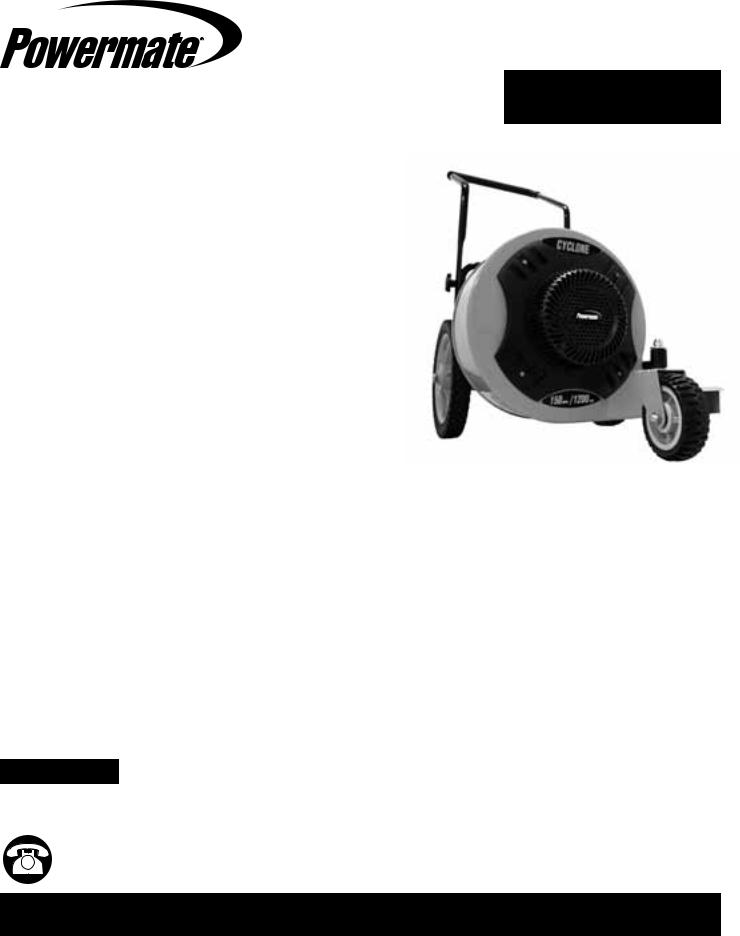
Operator’s Manual
Cyclone Walk Behind Blower
163 cc, 4 Cycle MODEL No. P-WB-163150 P-WB-163150-[E]
Look inside for:
|
Page |
Safety Definitions |
1 |
Important Safety Information |
2-4 |
Product Specifications |
5 |
Parts & Features |
5 |
Assembly |
6 |
Engine Preparation |
7-8 |
Operation |
8-11 |
Maintenance |
12-14 |
Technical Service |
15 |
Troubleshooting |
16 |
Warranty |
17-20 |
Español |
22 |
IMPORTANT:
Thank you for purchasing this Powermate® Cyclone Walk Behind Blower.
This manual provides complete instructions for safely operating and maintaining your Blower. Read and save these instructions. Refer to this manual each time before using your Blower.
Record the following for future reference:
Mfg. Date Code: _______________________
Date of Purchase: Attach a copy of your sales receipt.
Consumer Toll Free Number: 1-800-737-2112
 WARNING
WARNING
This product contains one or more chemicals known to the State of California to cause cancer and birth defects or other reproductive harm. Wash hands after handling.
If you have a question or problem...
CALL TOLL FREE: 1-800-737-2112
KEEP THIS MANUAL FOR FUTURE REFERENCE
05/13/2009 |
Printed in China |
A200133 |
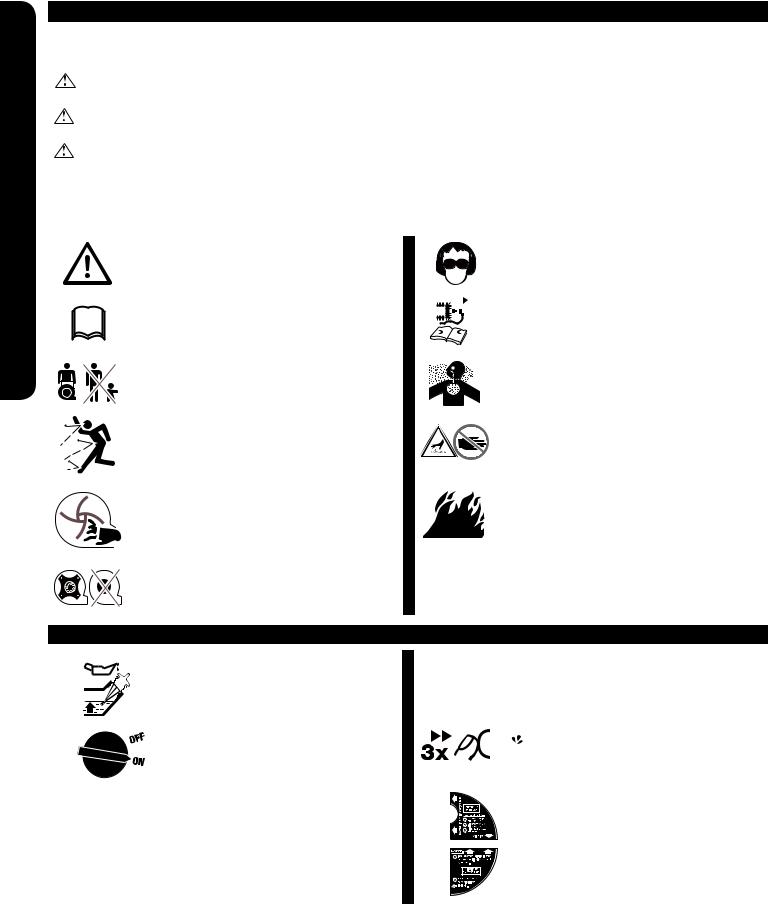
Information Safety Important
Safety Definitions
• Save these instructions
Safety Alert Symbols
The following symbols are used on the product and in this manual to alert the operator of potential safety hazards. Read them carefully, and understand their meaning.
|
|
|
|
|
|
|
|
|
|
|
|
|
Indicates an imminently hazardous situation which, if not avoided, will result in death or serious injury. |
||||||||||||
|
|
|
|
|
DANGER |
|
|
|
|||||||||||||||||
|
|
|
|
|
|
|
|
|
|
|
|
|
|
|
|
|
|
|
|
|
|||||
|
|
|
|
|
|
|
|
|
|
|
|
|
|
|
|
|
|
|
|
|
|
|
|
|
|
|
|
|
|
|
|
|
|
|
|
|
|
|
Indicates a potentially hazardous situation which, if not avoided, could result in death or serious injury. |
||||||||||||
|
|
|
|
|
WARNING |
|
|||||||||||||||||||
|
|
|
|
|
|
|
|
|
|
|
|
|
|
|
|
|
|
|
|||||||
|
|
|
|
|
|
|
|
|
|
|
|
|
|
|
|
|
|
|
|
|
|
|
|
|
|
|
|
|
|
|
|
|
|
|
|
|
|
|
Indicates a potentially hazardous situation which, if not avoided, may result in minor/moderate injury or |
||||||||||||
|
|
|
|
|
CAUTION |
|
|
||||||||||||||||||
|
|
|
|
|
|
|
equipment/property damage. |
|
|
|
|
|
|
|
|
|
|
|
|
||||||
|
|
|
|
|
|
|
|
|
|
|
|
|
|
|
|
|
|
|
|
|
|
|
|
|
|
The following symbols can be found on your blower. Carefully read and understand their meaning. |
|||||||||||||||||||||||||
|
|
|
|
|
|
|
|
|
|
|
|
|
|
|
|
|
|
|
|
|
|
||||
Safety Warning Symbols |
|
|
|
|
|
|
|
|
|
|
|
|
|||||||||||||
|
|
|
|
|
|
|
|
|
|
|
|
|
|
|
|
|
|
|
|
|
|
|
|
|
|
|
|
|
|
|
|
|
|
|
Indicates WARNING, DANGER, or CAUTION. |
|
|
|
|
|
|
|
|
|
|
|
Wear eye protection complying with ANSI Z87.1 |
||||
|
|
|
|
|
|
|
|
|
|
|
|
|
|
|
|
|
|
|
|
and hearing protection. |
|||||
|
|
|
|
|
|
|
|
|
|
|
|
|
|
|
|
|
|
|
|
|
|
|
|
|
|
|
|
|
|
|
|
|
|
|
|
|
|
|
|
|
|
|
|
|
|
|
|
|
|
|
|
|
|
|
|
|
|
|
|
|
Read operator’s manual before operating this |
|
|
|
|
|
|
|
|
|
|
|
Disconnect spark plug wire when not in use or |
||||
|
|
|
|
|
|
|
|
|
|
|
|
|
|
|
|
|
|
|
|
||||||
|
|
|
|
|
|
|
|
|
machine. Failure to follow directions could result |
|
|
|
|
|
|
|
|
|
|
|
before servicing, cleaning, or performing mainte- |
||||
|
|
|
|
|
|
|
|
|
in serious injury. |
|
|
|
|
|
|
|
|
|
|
|
nance on the unit. |
||||
|
|
|
|
|
|
|
|
|
|
|
|
|
|
|
|
|
|
|
|
||||||
|
|
|
|
|
|
|
|
|
|
|
|
|
|
|
|
|
|
|
|
||||||
|
|
|
|
|
|
|
|
|
|
|
|
|
|
|
|
|
|
|
|
|
|
|
|
|
|
|
|
|
|
|
|
|
|
|
Do not use if children or bystanders are present. |
|
|
|
|
|
|
|
|
|
|
|
Engine exhaust contains carbon monoxide, an |
||||
|
|
|
|
|
|
|
|
|
|
|
|
|
|
|
|
|
|
|
|
||||||
|
|
|
|
|
|
|
|
|
|
|
|
|
|
|
|
|
|
|
|
odorless and deadly gas. NEVER run unit indoors |
|||||
|
|
|
|
|
|
|
|
|
|
|
|
|
|
|
|
|
|
|
|
|
|
|
|
|
or in a poorly ventilated area. |
|
|
|
|
|
|
|
|
|
|
|
|
|
|
|
|
|
|
|
|
|
|
|
|
|
|
|
|
|
|
|
|
|
|
|
|
|
|
|
|
|
|
|
|
|
|
|
|
|
|
|
|
|
|
|
|
|
|
|
|
|
|
|
|
|
|
|
|
|
|
|
|
|
|
|
|
|
|
|
|
|
|
|
|
|
|
|
Unit will blow objects and debris at high speeds. |
|
|
|
|
|
|
|
|
|
|
|
Do NOT touch hot muffler or cylinder. These |
||||
|
|
|
|
|
|
|
|
|
Never stand in front of discharge chute. Never allow |
|
|
|
|
|
|
|
|
|
|
|
|||||
|
|
|
|
|
|
|
|
|
|
|
|
|
|
|
|
|
|
|
|
parts are extremely hot from operation and may |
|||||
|
|
|
|
|
|
|
|
|
discharge chute to point toward bystanders, pets, or |
|
|
|
|
|
|
|
|
|
|
|
|||||
|
|
|
|
|
|
|
|
|
|
|
|
|
|
|
|
|
|
|
|
remain hot for a short time after operation. |
|||||
|
|
|
|
|
|
|
|
|
valuable property. |
|
|
|
|
|
|
|
|
|
|
|
|||||
|
|
|
|
|
|
|
|
|
|
|
|
|
|
|
|
|
|
|
|
|
|||||
|
|
|
|
|
|
|
|
|
There are rotating blades inside the blower which |
|
|
|
|
|
|
|
|
|
|
|
To reduce risk of fire, clean spilled gas and oil and |
||||
|
|
|
|
|
|
|
|
|
can cause serious injury. Keep hands out of intake |
|
|
|
|
|
|
|
|
|
|
|
|||||
|
|
|
|
|
|
|
|
|
|
|
|
|
|
|
|
|
|
|
|
keep unit free from debris. Gasoline is extremely |
|||||
|
|
|
|
|
|
|
|
|
and discharge openings. Never insert foreign objects |
|
|
|
|
|
|
|
|
|
|
|
|||||
|
|
|
|
|
|
|
|
|
|
|
|
|
|
|
|
|
|
|
|
flammable. Allow machine to cool completely before |
|||||
|
|
|
|
|
|
|
|
|
such as sticks or tools into the intake guards or |
|
|
|
|
|
|
|
|
|
|
|
|||||
|
|
|
|
|
|
|
|
|
|
|
|
|
|
|
|
|
|
|
|
refueling. |
|||||
|
|
|
|
|
|
|
|
|
discharge chute. |
|
|
|
|
|
|
|
|
|
|
|
|||||
|
|
|
|
|
|
|
|
|
|
|
|
|
|
|
|
|
|
|
|
|
|||||
|
|
|
|
|
|
|
|
|
|
|
|
|
|
|
|
|
|
|
|
|
|
|
|
|
|
|
|
|
|
|
|
|
|
|
Do NOT operate machine without shields, guards, |
|
|
|
|
|
|
|
|
|
|
|
|
||||
|
|
|
|
|
|
|
|
|
|
|
|
|
|
|
|
|
|
|
|
|
|||||
|
|
|
|
|
|
|
|
|
and safety devices (e.g. intake guard) in place and |
|
|
|
|
|
|
|
|
|
|
|
|
||||
|
|
|
|
|
|
|
|
|
working. |
|
|
|
|
|
|
|
|
|
|
|
|
|
|||
|
|
|
|
|
|
|
|
|
|
|
|
|
|
|
|
|
|
|
|
|
|
|
|
|
|
Control and Operating Symbols
|
|
|
|
|
|
Oil Fill Location |
|
|
|
|
|
Gasoline Fill Location |
|
|
|
|
|
|
|
|
|
|
|
||
|
|
|
|
|
|
Do Not Overfill |
|
|
|
|
|
Do Not Overfill |
|
|
|
|
|
|
|
|
|
|
|
|
|
|
|
|
|
|
|
On/Off Switch |
|
|
|
|
|
Push primer 3 times before starting a cold |
|
|
|
|
|
|
|
|
|
|
|
||
|
|
|
|
|
|
|
|
|
|
|
||
|
|
|
|
|
|
|
|
|
|
|
engine - may not be requireed to restart a |
|
|
|
|
|
|
|
Switch to “OFF” to stop unit |
|
|
|
|
|
|
|
|
|
|
|
|
|
PUSH TO PRIME |
warm engine. |
||||
|
|
|
|
|
|
|
|
|||||
|
|
|
|
|
|
|
|
|
|
|
|
|
|
|
|
|
|
|
Rotate index lever to change airflow angle: |
|
|
|
|
|
Instructions for attaching Front Flow Attach- |
|
|
|
|
|
|
|
|
|
|
|
||
|
|
|
|
|
|
15º down, Level, 15º up |
|
|
|
|
|
ment to Unit |
|
|
|
|
|
|
|
|
|
|
|
|
|
|
|
|
|
|
|
|
|
|
|
|
|
|
|
|
|
|
|
|
Instructions for storing Front Flow |
|
|
|
|
|
Instructions of Front Flow Attachment stor- |
|
|
|
|
|
|
|
|
|
|
|||
|
|
|
|
|
|
Attachment under frame |
|
|
|
|
|
age on unit |
|
|
|
|
|
|
|
|
|
|
|
|
|
Questions? Call Toll Free at 1-800-737-2112 |
1 |
Copyright © 2009 MAT Engine Technologies, LLC |
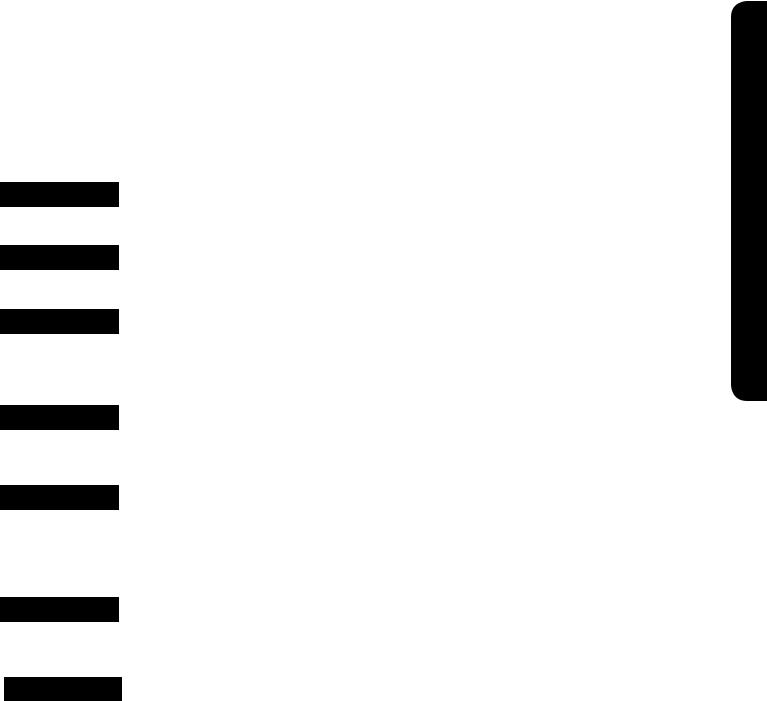
Important Safety Information
• Save all instructions
RESPONSIBILITY OF OPERATOR
1. Carefully read and follow these safety instructions. Failure to do so can result in serious injury.
2. Know your product. Read and understand this manual before use. Compare the illustrations to unit. Learn location
and function of all controls. Thoroughly understanding the unit before use will result in the best performance and safety. 3. Follow all instructions when assembling the unit. If the unit was purchased in assembled condition, the operator must
check the unit carefully to make sure it was assembled according the instructions in the manual before use. 4. Regularly inspect the blower. Make sure parts are not bent, damaged, or loose.
5. Use this equipment for its intended purpose only.
6. Operate the unit only with guards, shields, and other safety items in place and working correctly. 7. Service the unit only with authorized or approved replacement parts.
8. Complete all unit maintenance and adjustments according to the instruction in this manual.
 WARNING
WARNING
Look for this symbol to point out important safety precautions. It means: “ Attention! Become Alert! Your Safety Is Involved.”
 WARNING
WARNING
Engine Exhaust, some of its constituents, and certain vehicle components contain or emit chemicals known to the State of California to cause cancer and birth defects or other reproductive harm.
 WARNING
WARNING
To prevent accidental starting when setting up, transporting, adjusting or making repairs, always disconnect spark plug wire and put wire where it cannot contact the spark plug.
PREPARATION SAFETY
 WARNING
WARNING
•Read, understand, and follow all instructions on the machine and in this manual. Be thoroughly familiar with the controls and the proper use of the blower before starting. Know how to stop the engine quickly.
•Familiarize yourself with all the safety and operating decals on this equipment.
 CAUTION
CAUTION
•Blower will propel debris at high speed and can cause damage. Before use, check that area is free from breakable objects, such as house windows, auto glass, greenhouses, etc.
•Check that all nuts and bolts are tight and equipment is in good condition.
OPERATION SAFETY
 WARNING
WARNING
•Keep area of operation clear of all bystanders, particularly small children and pets.
•Never allow children or young teenagers to operate the walk behind blower. Only allow responsible individuals, who are familiar with the instructions, to operate the blower.
 WARNING
WARNING
•Do not operate the blower while under the influence of alcohol, drugs, or other medication which can cause drowsiness or affect your ability to operate this machine safely.
•Do not use this machine if you are mentally or physically unable to operate the machine safely.
•This equipment was designed specifically for the purpose of blowing leaves and debris. Do NOT use this equipment for any other purpose.
•Always wear ANSI compliant safety goggles or safety glasses with side shields when operating blower to protect your eyes from foreign objects, which can be thrown from the unit.
•Wear appropriate clothing such as a long sleeved shirt or jacket. Also wear long trousers or slacks. Do NOT wear shorts. Do NOT wear loose clothing, which could get caught in this equipment.
•Always wear work gloves and sturdy footwear such as leather work shoes or short boots. These will protect ankles and shins from small sticks, splinters, and other flying debris, and improve traction.
•It is advisable to wear protective headgear to protect against being struck by small flying particles, or being struck by low hanging branches, twigs, or other objects, which may be unnoticed by the operator.
Important Safety Information
Questions? Call Toll Free at 1-800-737-2112 |
2 |
Copyright © 2009 MAT Engine Technologies, LLC |

Information Safety Important
Important Safety Information (Continued)
• Save all instructions
OPERATION SAFETY (Continued)
 WARNING
WARNING
•There are rotating blades inside blower which can cause serious injury. NEVER place hand or anything else in the intake or discharge openings when machine is running.
 WARNING
WARNING
•Do NOT operate without shields and guards (such as the intake guard) in place and secure.
•Do not stand or put your hand in front of the discharge opening. Always pay attention to the direction of the discharge opening. Never allow discharge opening to point towards bystanders, pets, or valuable property.
•Exercise extreme caution when operating on or crossing gravel drives, walks, or roads. Stay alert for hidden hazards or traffic.
 WARNING
WARNING
•Exercise caution to avoid slipping or falling. Always be sure of your footing; keep a firm hold on the handle and walk; never run. Never operate the blower at high transport speeds on slippery surfaces.
•Look behind and use care when backing.
•Never operate the blower without good visibility or light.
 DANGER
DANGER
•Do not run the engine indoors or inside a closed area. The exhaust fumes are dangerous, containing CARBON MONOXIDE, an ODORLESS AND DEADLY GAS.
•Never leave the blower unattended when the engine is running. Stop the engine and make sure all moving parts have stopped. Remove the wire from the spark plug.
•If the blower should start to vibrate abnormally, stop the engine, disconnect the spark plug wire and prevent it from touching the spark plug. Check immediately for the cause. Vibration is generally a warning of trouble.
•Watch for holes, ruts, bumps, or other rough ground. Tall grass can hide obstacles.
•Never pick up or carry machine when engine is running.
FUEL SAFETY
 WARNING
WARNING
•Gasoline is extremely flammable, and gasoline vapors can explode if ignited. Handle with care.
•Wash skin or clothes immediately if they come in contact with gasoline.
•Use an approved container.
•Check fuel supply before each use, allowing space for expansion as the heat of the engine and/or sun can cause fuel to expand.
•Fill fuel tank outdoors with extreme care. Never fill fuel tank indoors. Never fill fuel tank while machine is in a vehicle.
•Never remove gas cap or add fuel with the engine running. Allow engine to cool completely before refueling.
 WARNING
WARNING
•Do not smoke while refueling.
•After refueling, replace fuel tank cap securely and wipe up spilled fuel.
•Never store fuel or blower with fuel in the tank inside a building where fumes may reach an open flame.
STORAGE SAFETY
• Always refer to the operator’s manual instructions for important details if the blower is to be stored for an extended period.
• Never store the blower with fuel in the fuel tank inside a building where ignition sources are present such as water heaters, space heaters, clothes dryers, etc.
• To reduce fire hazard, keep blower free of grass, leaves, or other debris build-up.
• Allow the engine to cool before storing in any enclosure.
REPAIR, MAINTENANCE, AND ADJUSTMENT SAFETY
Questions? Call Toll Free at 1-800-737-2112 |
3 |
Copyright © 2009 MAT Engine Technologies, LLC |
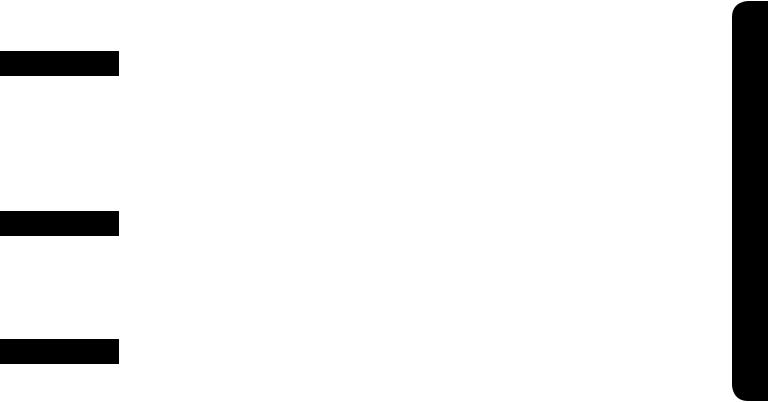
Important Safety Information (Continued)
•Save all instructions
•After striking a foreign object, stop the engine. Remove the wire from the spark plug and keep the wire away from the plug to prevent accidental starting. Thoroughly inspect the blower for any damage. If damaged, have the
equipment repaired by a trained technician before restarting and operating.
 WARNING
WARNING
•Stop the engine before cleaning, repairing, or inspecting the unit. Make sure all moving parts have stopped. Let the engine cool, disconnect the spark plug wire and move it away from the spark plug.
•Never attempt to make any adjustments while the engine is running.
•Keep the blower in safe working condition. Check all fasteners at frequent intervals for proper tightness.
•When servicing or repairing the blower, do not tip the machine over or up unless specifically instructed to do so in this
Manual. Service and repair procedures can be done with the blower in an upright position. Some procedures will be easier if the machine is lifted on a raised platform or working surface.
•Use only original equipment or authorized replacement parts.
 WARNING
WARNING
•Never tamper with safety devices. Check their proper operation regularly.
•Do not change the engine governor setting or over-speed engine.
•Clean and replace safety and instruction decals as necessary.
•To guard against engine over-heating, always have engine air filter mounted and clean.
CHILDREN SAFETY
 WARNING
WARNING
•Tragic accidents can occur if the operator is not alert to the presence of children. Children are often attracted to the blower and the leaf clearing activity.
•Keep children out of the area of operation and under the watchful care of a responsible adult.
•Never assume that children will remain where you last saw them.
•Be alert and turn blower off if children enter the area.
•Before and while moving backwards, look behind and down for small children.
•Never allow children to operate the blower.
•Use extra care when operating near blind corners, shrubs, trees, or other objects that may obstruct vision.
Important Safety Information
Questions? Call Toll Free at 1-800-737-2112 |
4 |
Copyright © 2009 MAT Engine Technologies, LLC |
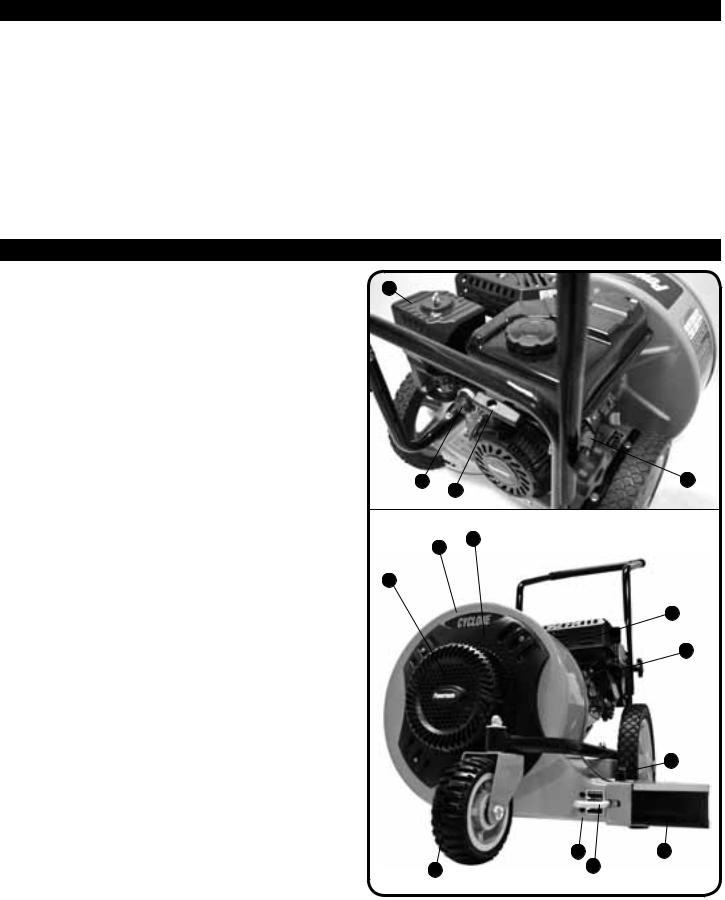
Specifications
• Save all instructions
Unit Weight . . . . |
. . . . . |
. |
. . . |
88 lb. (40 kg) |
Maximum Air Flow . . |
. . . . . |
. |
150 MPH / 1200 CFM |
|
Fan Diameter . . . . |
. . . . . |
. . 13 in. (330 mm) |
||
Fan Construction . . |
. . . . . |
4 Steel Blades, welded |
||
Gasoline Type . . . |
Regular Unleaded / 88 Octane (min.) |
|||
Gasoline Capacity . . |
. . . . . |
. |
. . |
. 3.5 qt. (3.3L) |
Oil Type (API SG-SL) |
10W-30 is recommended for all ser- |
|||
vice temperatures. See page 7 for additional information. Oil Capacity . . . . . . . . . . . . . 19 oz (562 ml)
Parts & Features
Spark Plug Model . . . . |
. |
. . . . . . Torch F7RTC |
|
Spark Plug Gap . . . . . |
. 0.028-0.031 in. (0.7-0.8 mm) |
||
Engine Type . . . . . . |
4 Stroke, single cylinder, OHV |
||
Displacement . . . . . . . |
. . . . . . . |
. . 163cc |
|
RPM . . . . . . . . . |
. . . . . . . . |
3600 RPM |
|
Torque Rating . . . 6.5 ft-lbs gross torque per SAE J1940 Bore Diam. x Stroke . . . . . . 2.7X1.8 in. (68X45 mm) Intake Valve Clearance . 0.0032-0.0047 in.(0.08-0.12 mm) Exhaust Valve Clearance . 0.0059-0.0079 in.(0.15-0.20mm) Angle of Ignition . . . . . . . . . . . . . . . . . . . . . . . . 25 Degrees
1.Fan – Rotating element which generates air flow
2.Fan Housing – Outer component which houses the fan
3.Intake Guard – Prevents fingers, hands, or large debris from entering the fan housing and contacting the fan blades
4.Discharge Chute – The location where the air flow exits the fan housing. Flow direction is to the left side of the unit from machine operator’s position.
5.Flow Angle Adjustment – Vertically adjusts the direction of air flow between 3 positions: level, 15 degrees up, and 15 degrees down.
6.Front Flow Attachment – Redirects the air flow toward the front of the unit. Can be removed and stored under the frame when not in use.
7.Attachment Knob – Secures attachments to the discharge chute
8.Front Swivel Wheel – 360 degree swiveling wheel to allow for maneuverability.
9.ON/OFF Switch – Stops the engine when turned to “OFF”. Must be turned to “ON” for engine to start and run.
10.Primer Bulb – Injects fuel mixture into the carburetor for ease of starting the engine.
11.Muffler – Location of engine exhaust.
12.Air Filter – Removes debris and contaminates from intake air, allowing engine to run smoothly and maintain engine life.
13.Recoil Starter Handle – The engine is equipped with an easy pull recoil starter.
14.Spark Plug/Spark Plug Wire – Provides spark to ignite air/ fuel mixture. The Spark Plug Wire must be disconnected and moved away from the Spark Plug when servicing the unit.
12
10 |
|
9 |
REAR VIEW |
|
13 |
|
|
|
|
|
FRONT VIEW |
|
2 |
3 |
|
|
|
1 (inside) |
|
|
|
|
11 |
|
|
14 |
7
4 |
|
6 |
8 |
5 |
Figure 1 |
|
||
|
|
Questions? Call Toll Free at 1-800-737-2112 |
5 |
Copyright © 2009 MAT Engine Technologies, LLC |
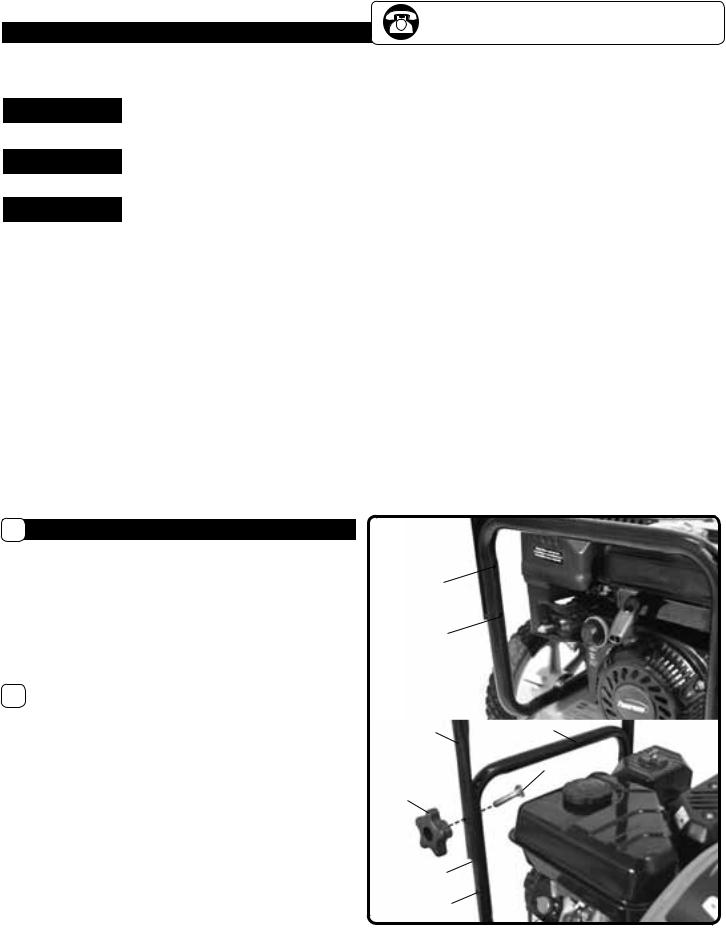
Assembly
• Save all instructions |
If you need assistance or find any parts missing, CALL |
|
|
|
TOLL FREE: 1-800-737-2112. |
Read and follow the assembly instructions. Do not discard any parts or materials until the unit is assembled. References to the right or left side of the blower are from the viewpoint of the operator’s position behind the blower.
 WARNING
WARNING
Do not operate blower if it is damaged or not completely and correctly assembled.
 WARNING
WARNING
Before doing any assembly or maintenance to the unit, remove the wire from the spark plug.
 WARNING
WARNING
Always wear ANSI compliant safety glasses with side shields while assembling the blower.
The following components will be found in the carton.
Quantities shown in ( ).
1. (1) Walk Behind Blower
2. (1) Blower Operator’s Manual
3. (1) Handle
4. (1) Front Flow Attachment (stored under the frame)
5. (1) Bottle of SAE 30 Engine Oil
6. (1) Parts bag containing the following:
(2) Plastic Wing Nuts (M8)
(2) M8x35mm Pipe Bolts
(1) Spark plug socket wrench w/ rod
A How to Remove Blower from Carton
1.Remove all parts and packaging components.
2.Use a utility knife to cut all 4 vertical edges and lay the side panels flat around the blower.
3.Remove any remaining packaging.
4.Roll the unit out from the carton, and place on a hard level surface.
Upper
Tube Hole
Middle
Tube Hole
B How to Assemble the Handle |
|
|
|
NOTE: There are two positions in which the handle can be |
|
|
|
|
Handle |
Frame Tubing |
|
attached – a high position and a low position. (See Figure 2) |
|
||
1. Assemble the handle tabs into the holes on the lower |
|
Plastic |
Pipe Bolt |
frame tubing. Use the bottom holes for the low handle |
|
|
|
|
Wing Nut |
|
|
position. Use the middle holes for the high handle |
|
|
|
|
|
|
|
position. (See Figure 2) |
|
|
|
2. Secure the handle onto the frame tubing with the (2) pipe |
|
|
|
bolts and the (2) plastic wing nuts. Firmly hand-tighten |
|
|
|
the wing nuts. (See Figure 2) |
|
Handle Tab |
|
|
|
Bottom |
Figure 2 |
|
|
Tube Hole |
|
Questions? Call Toll Free at 1-800-737-2112 |
6 |
|
Copyright © 2009 MAT Engine Technologies, LLC |
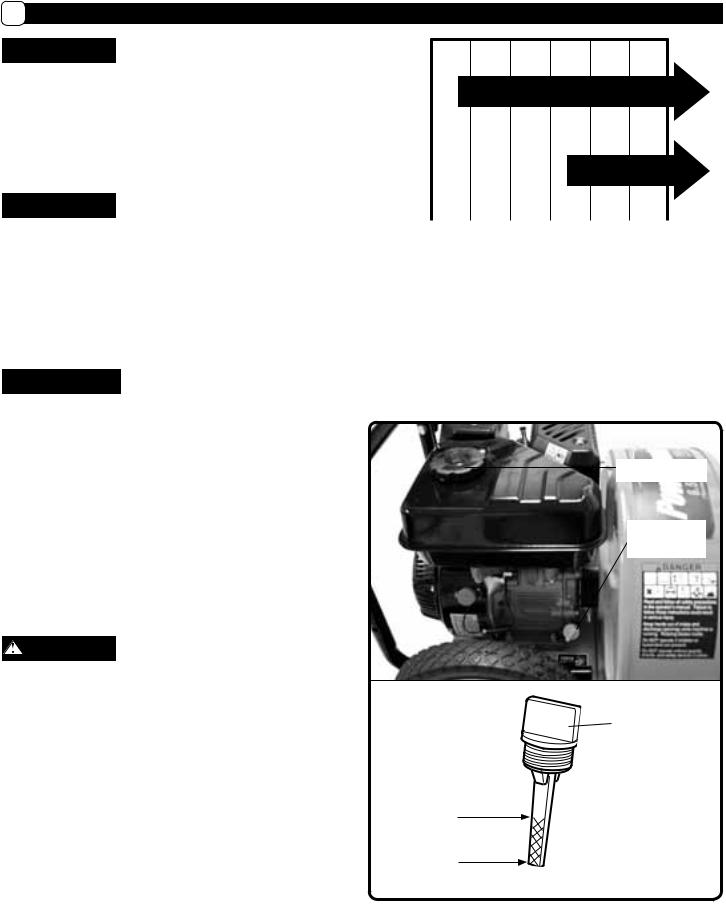
Engine Preparation
• Save all instructions
A Engine Oil
 CAUTION
CAUTION
Engine shipped without oil. Failure to add oil will result in serious engine damage.
A bottle of SAE 30 engine oil is included with your blower. Refer to the chart on the right for alternative oil types to use at different temperatures. Always use a high quality detergent oil classified “For Service, SG, SH, SJ” or higher.
Do not use special additives.
 CAUTION
CAUTION
Always use recommended oil type. Using dirty oil or incorrect oil type such as 2-stroke engine oil will shorten engine life.
NOTE: Engine Oil Capacity is 562 ml. For first time fill, simply add the entire contents of the provided oil bottle to the crankcase.
SAE
SAE 10W-30
|
|
|
|
|
|
|
|
|
|
|
SAE 30 |
|
|
|
|
|
|
|
|
|
|
|
|
|
|
|
|
|
|
|
|
|
|
TEMP -20 |
0 |
20 |
40 |
60 |
80 |
|
100° F |
|||||||||
|
|
|
|
|
|
|
|
|
|
|
|
|
|
|
|
|
-30 |
|
-20 |
-10 |
0 |
10 |
20 |
30 40° C |
|||||||||
|
|
|
|
Ambient Service Temperature |
|
|
|
|
||||||||
HOW TO CHECK OIL LEVEL AND FILL TO PROPER LEVEL
 WARNING
WARNING
Before checking oil, make sure engine is off, and spark plug wire has been disconnected from spark plug.
1.Set walk behind blower on a level surface.
2.Remove the oil fill cap/dipstick and wipe clean with cloth.
(See Figure 3)
3.Insert dipstick into fill spout but do NOT screw in.
Remove dipstick and check oil level.
4.When oil level is full, the oil will be at upper limit on dip stick. If oil level is near or below the lower limit, oil must be added. (See Figure 4)
5.Add oil slowly until the oil level reaches the upper limit of the dipstick. Use a funnel or nozzle to reduce spillage.
Fuel Tank Cap
Oil Fill Cap/
Dipstick
|
CAUTION |
Figure 3 |
|
Frequently check oil level while filling. DO NOT OVERFILL. |
|||
|
|||
DO NOT UNDERFILL. Running engine at improper oil level |
|
||
will seriously damage engine. |
Oil Fill Cap/ |
||
6. |
Replace and tighten dipstick. |
||
Dipstick |
|||
7. |
Clean up any spilled oil. |
||
|
|||
Upper Limit
Lower Limit
Figure 4
Questions? Call Toll Free at 1-800-737-2112 |
7 |
Copyright © 2009 MAT Engine Technologies, LLC |
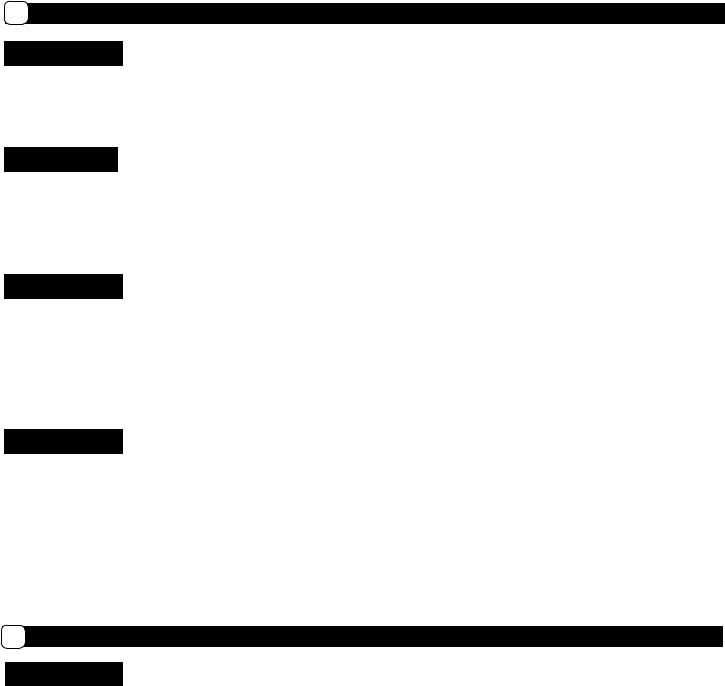
Engine Preparation (Continued)
• Save all instructions
B Fuel
 WARNING
WARNING
• Gasoline is extremely flammable and vapors can explode if ignited. Handle with care. Use fresh, clean, regular-unleaded gasoline with a minimum of 88 Octane.
Do NOT use leaded gasoline, gasohol, methanol, or diesel fuel. Do NOT mix oil with gasoline. Do NOT allow gasoline to become contaminated with dust, water, or debris.
 CAUTION
CAUTION
Using incorrect fuel type or contaminated fuel will cause serious engine damage.
NOTE: Fuel tank capacity is approximately 3.5 qt (3.3L)
HOW TO FILL ENGINE WITH FUEL
 WARNING
WARNING
•Turn engine off and let engine cool for several minutes before removing the fuel cap or adding fuel.
•Never fill fuel tank indoors.
•Do not smoke while adding fuel.
1.Clean surface around fuel tank cap to prevent contamination. (See Figure 3)
2.Loosen fuel cap slowly. After removing cap, place on a clean surface.
3.Pour fuel into the tank. Use care to avoid spillage.
 WARNING
WARNING
Do NOT OVERFILL fuel. Allow space for the fuel to expand due to heat from engine and/or sun.
4.Before replacing the fuel cap, inspect and clean the fuel cap seal.
5.Replace the fuel cap and securely hand-tighten.
6.Clean up any spilled fuel.
Operation
• Save all instructions
A Before Starting the Engine
 WARNING
WARNING
Before starting engine, read operator’s manual. Become familiar with location and function of all controls. Know how to stop the engine quickly.
Before attempting to start the engine, review the following steps:
1.Unit has been assembled according to all assembly instructions.
2.Unit has been inspected for any damaged or missing components.
3.No parts are remaining in the carton.
4.Engine oil is at proper level.
5.Fresh, clean, regular-unleaded gasoline has been added to fuel tank.
6.Spark plug wire is connected to spark plug.
7.Blower has been moved to desired location.
8.Blower is on level surface.
Questions? Call Toll Free at 1-800-737-2112 |
8 |
Copyright © 2009 MAT Engine Technologies, LLC |

Operation
• Save all instructions
A |
Before Starting the Engine (Continued) |
 WARNING
WARNING
Keep all bystanders, especially CHILDREN, away during operation.
IMPORTANT: This unit’s engine exhaust system is equipped with a spark-arresting muffler. Tampering with or removing the spark-arrestor violates section 4442 of the California Public Resources Code as well as other applicable state and federal law.
B How to Start Engine
9
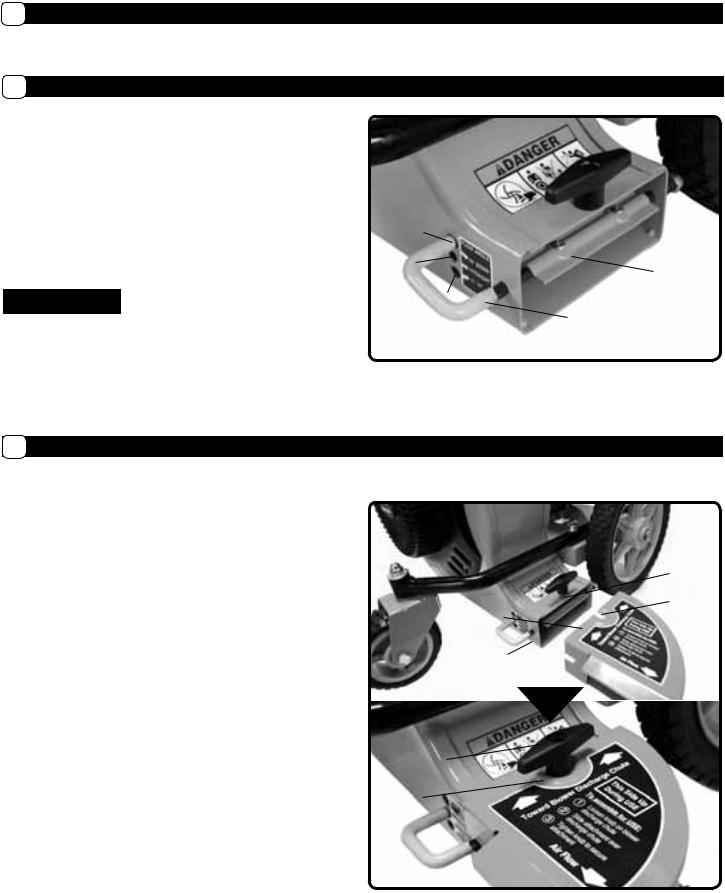
Operation (Continued)
• Save all instructions
C How to Stop the Blower
Move the ON/OFF Switch to the OFF position. (See figure 6)
D How to Adjust the Vertical Flow Angle
The vertical air flow direction can be adjusted between 3 positions: Straight (level), 15 degrees upward, and 15 degrees downward. Refer to Figure 8 when performing the adjustment steps below:
1.Stop the engine.
2.Pull the index lever out of its existing hole.
3.Rotate the index lever to the desired position.
4.Release the index lever and allow it to insert into the desired hole.
 WARNING
WARNING
Never adjust the flow angle when engine is running. Never stand or put your hand in front of the discharge opening when the engine is running. Never put hands, fingers, or anything else inside the discharge opening when the engine is running. There are rotating blades inside which can cause serious injury.
15° Downward |
|
|
Level |
|
Air Flow |
|
|
|
15° Upward |
|
Louver |
|
|
|
|
Adjustment |
|
|
Lever |
Figure 8 |
|
|
E How to Redirect Air Flow toward the Front
A Front Flow Attachment is included with your blower. Assembling this attachment to the blower will cause the air flow to |
|||||||
be redirected to the front of the blower. |
|
|
|
|
|||
To assemble this attachment to the blower, follow the steps |
|
|
|
||||
below and refer to Figure 9: |
|
|
|
|
|
||
1. |
Stop the engine. |
|
|
|
|
Bolt |
|
2. |
Rotate the vertical adjustment lever to the level position |
|
|
Slot |
|||
|
(See Figure 8) |
|
|
|
|
||
3. |
Loosen the attachment knob located on top of the blower |
Front Flow |
|||||
Attachment |
|||||||
|
discharge chute |
|
|
||||
4. |
Orient the attachment so the “This Side Up For USE” is up. |
Discharge |
|
|
|||
5. |
Slide the front flow attachment over the discharge |
Chute |
|
|
|||
|
chute with the orientation identified on the label. The slot |
|
|
|
|||
|
on the top of the front flow |
attachment will |
mate |
|
|
|
|
|
|
|
|
||||
|
with the bolt of the attachment knob. |
the |
|
|
|
||
6. Hand-tighten the attachment |
knob to secure |
|
|
|
|||
|
attachment. |
|
|
Attachment |
|||
Note: when properly assembled, the attachment knob will fit |
Knob |
||||||
Round |
|||||||
inside of the round emboss on the top of the attachment. |
|||||||
|
|
|
|
Emboss |
|||
Figure 9
Questions? Call Toll Free at 1-800-737-2112 |
10 |
Copyright © 2009 MAT Engine Technologies, LLC |
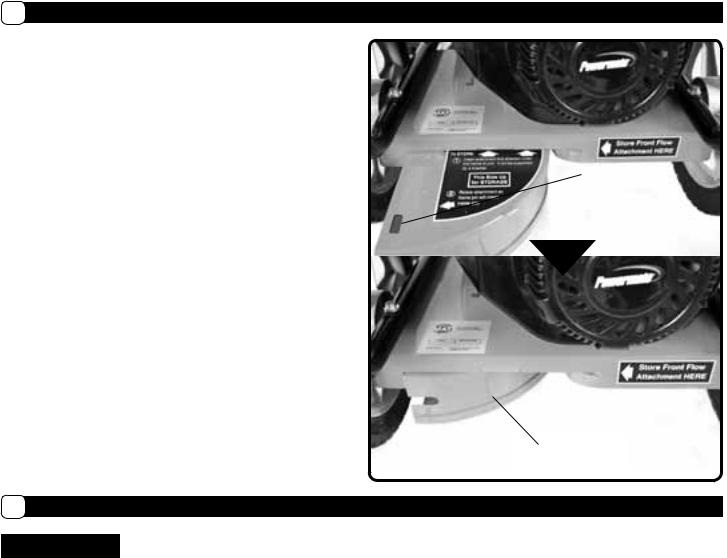
Operation (Continued)
• Save all instructions
E How to Redirect Air Flow toward the Front (Continued)
When not in use, the front flow attachment can be stored |
|
|
|
|
under the frame at the rear of the unit. To secure the |
|
|
|
|
attachment for storage, follow the steps below and refer to |
|
|
|
|
Figure 10: |
|
|
|
|
1. |
Turn the attachment so “This Side Up For STORAGE” is up. |
|
|
|
2. |
Insert the attachment into frame opening, with the |
|
|
|
3. |
orientation identified on the label. |
|
|
|
The edge of the attachment will be supported by a bracket |
|
|
|
|
4. |
under the frame. |
|
|
Slot |
Secure the attachment by forcing it upward and rotating |
|
|
|
|
|
it so the pin on the frame will insert into the slot on the |
|
|
|
|
attachment. |
|
|
|
|
|
|
|
|
|
|
|
|
|
|
|
Support |
||
|
|
Rod |
||
Front Flow |
|
Attachment |
Figure 10 |
E Tips for Using your Walk Behind Blower
 WARNING
WARNING
Read the Operator’s manual. Know location and functions of all controls. Keep all safety devices and shields in place. Never allow children or uninstructed adults to operate the blower. Keep bystanders away from machine. Keep away from the fan intake opening and discharge chute, as the fan is rotating and can cause severe injury.
•Blowing leaves is best performed when conditions are dry.
•To clear a very large and/or heavy pile of leaves, make two passes: First point the directional adjustment upward to move the top of the pile. Then point the directional adjustment downward to move the base of the pile.
•When clearing leaves, always pay attention to natural wind direction and blow the leaves the same direction as the natural wind.
•To clear a small area, corral the leaves in the center by circling several times around the perimeter of the area.
•To clear a large area, move the leaves from one side to the other by making back and forth passes.
•Before starting a cleaning project, plan how the leaves will be collected and disposed.
Questions? Call Toll Free at 1-800-737-2112 |
11 |
Copyright © 2009 MAT Engine Technologies, LLC |
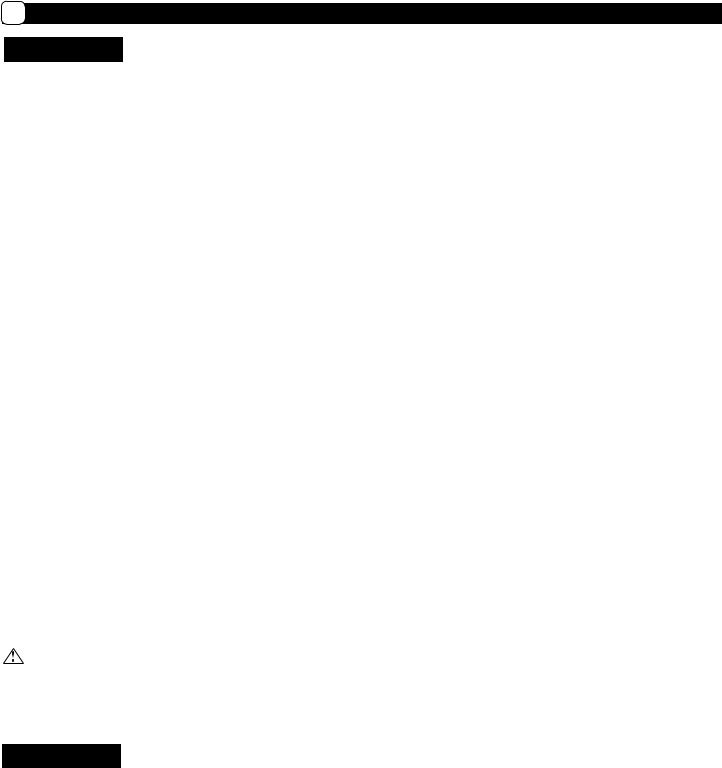
Maintenance
• Save all instructions
A |
Maintenance Schedule |
 WARNING
WARNING
Before performing any maintenance, turn engine off and remove the wire from the spark plug to prevent accidental starting and serious injury.
IMPORTANT: The warranty on this blower does not cover items that have been subjected to operator abuse or negligence. To receive full value from the warranty, the operator must maintain the blower as instructed in this manual, and only use genuine replacement parts. The following table lists required periodic maintenance.
PERIODIC MAINTENANCE SCHEDULE TABLE
Service Records- |
|
|
After |
After Every |
After Every |
After Every |
Before |
|
See |
||
|
Before |
Every |
Before |
||||||||
Fill in dates as you complete regular |
25 Hours |
50 Hours of |
100 Hour |
Each |
Note |
||||||
Each Use |
10 Hours |
Storage |
|||||||||
service |
|
of Use |
Use |
of Use |
Season |
Below |
|||||
|
|
of Use |
|
||||||||
|
|
|
|
|
|
|
|
|
|
||
|
|
|
|
|
|
|
|
|
|||
Check Engine Oil Level, |
√ |
|
|
|
|
√ |
|
|
|||
Fill to Proper Level |
|
|
|
|
|
|
|
||||
|
|
|
|
|
|
|
|
|
|||
Clean Debris From Unit |
√ |
|
|
|
|
√ |
√ |
|
|||
|
|
|
|
|
|
|
|
|
|||
Lubricate All Pivot Points |
|
√ |
|
|
|
√ |
√ |
|
|||
|
|
|
|
|
|
|
|
|
|||
Check Fasteners for Tightness |
|
√ |
|
|
|
√ |
|
1 |
|||
|
|
|
|
|
|
|
|
|
|
||
Check Fuel Line |
|
|
|
√ |
|
|
√ |
|
|
||
Replace if Necessary |
|
|
|
|
|
|
|
|
|
||
Lubricate Wheel Axles |
|
|
√ |
|
|
√ |
√ |
|
|||
Check Spark Plug |
|
|
|
√ |
|
|
√ |
|
|
||
Replace if Necessary |
|
|
|
|
|
|
|
|
|
||
Change Engine Oil |
|
|
|
|
√ |
|
√ |
√ |
2,3 |
||
|
|
|
|
|
|
|
|
|
|
||
Clean Air Filter |
|
|
|
|
√ |
|
√ |
|
4 |
||
Replace if Necessary |
|
|
|
|
|
|
|
|
|
||
Replace Spark Plug |
|
|
|
|
√ |
|
|
|
|||
|
|
|
|
|
|
|
|
|
|||
Clean Combustion Deposits from |
|
|
|
|
√ |
|
|
|
|||
Cylinder, Piston, and Valves |
|
|
|
|
|
|
|
||||
|
|
|
|
|
|
|
|
||||
|
|
|
|
|
|
|
|
|
|
|
|
CAUTION |
|
IMPORTANT NOTES about Maintenance schedule |
|
|
|
|
|
||||
1.Re-check tightness of all fasteners after first 2 hours of initial use.
2.Change engine oil after first 5-8 hours of initial use.
3.Change oil every 25 hours if operating in dusty conditions or in high temperatures.
4.Clean air filter every 10 hours if operating under dusty conditions.
 WARNING
WARNING
Use only GENUINE replacement parts. Other parts may damage the unit or result in injury.
Questions? Call Toll Free at 1-800-737-2112 |
12 |
Copyright © 2009 MAT Engine Technologies, LLC |
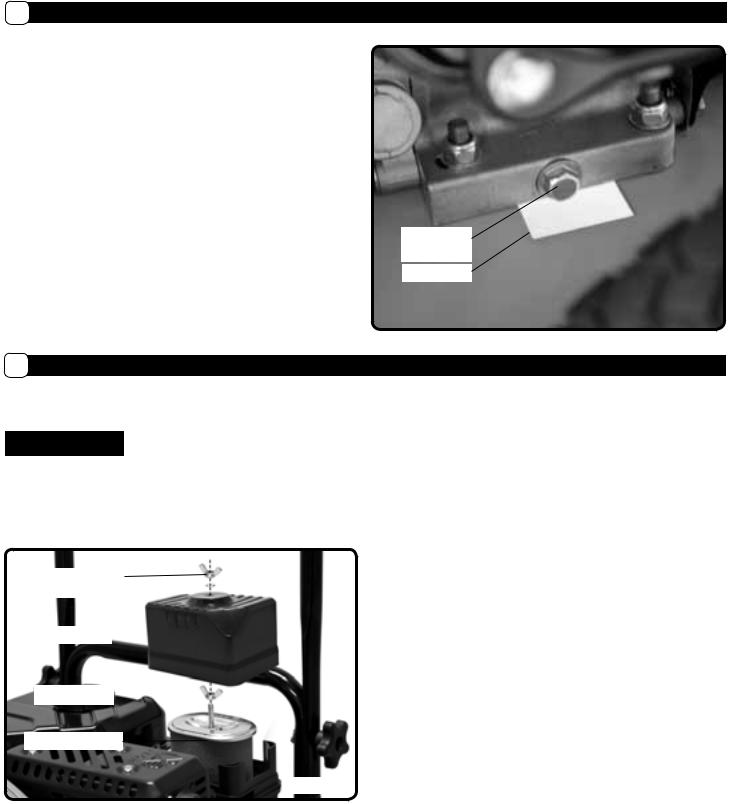
Maintenance (Continued)
• Save all instructions
B How to Change the Engine Oil
NOTE: Refer to Figure 11 when following the steps below:
1.Stop the engine and let it cool.
2.Disconnect spark plug wire from the spark plug.
3.Insert a flat pan under the blower, underneath the oil drain plug and frame hole.
4.Remove oil dipstick. (See Figure 3)
5.Remove the oil drain bolt and washer.
6.Allow all oil to drain through the frame hole into the pan.
IMPORTANT: Used oil is a hazardous waste. Place oil in a sealed container and take to your local recycling center. Do NOT discard with household waste.
7.Replace and tighten the oil drain plug and washer.
8.To re-fill engine with oil, see engine preparation section
“How to Check Oil and Fill to Proper Level.”
C How to Clean the Air Filter
A dirty air filter will restrict air intake. Regular maintenance of air cleaner will help improve engine performance and reduce emissions.
 WARNING
WARNING
Never clean air filter with gasoline or an easy ignited solvent because it may cause explosion.
IMPORTANT: Only use replacement air filter from the manufacturer. To order spare parts call us at 1-800-737-2112
Outer Wingnut
Washer 
Air Filter Cover 
Inner Wingnut 
Air Filter Element
Figure 12
Drain Plug
and Washer
Frame Hole
Figure 11
NOTE: Refer to Figure 12 when following steps below:
1. Remove the outer wing nut, washer, and air filter cover. 2. Remove the inner wing nut, and the air filter.
IMPORTANT: Use care when removing the air filter so dirt and debris does not fall into the carburetor.
NOTE: Air filter is made up of an outer foam element and an inner paper element.
3. Separate the outer foam element from the inner paper element.
4. Check the inside of the paper element for dirt or debris. 5. Check both elements for tears.
NOTE: If the inner paper element is dirty or if either element is torn, replace with a new air filter from the manufacturer.
6. Clean the outer foam element by washing it thoroughly in a solution of household detergent and water, or in a nonflammable or high flash point solvent. Allow to
dry thoroughly. Then soak the foam element in clean engine oil, and squeeze out all excess oil.
7. Clean the inner paper element by lightly tapping it against a hard surface to remove excess dirt or by blowing compressed air through the filter from the inside out.
IMPORTANT: Do not attempt to brush dirt off the paper element, as this will only embed dirt into the fibers.
8. Reinstall the cleaned out foam element onto the inner paper element.
9. Reinstall the clean air filter and cover onto the unit by reversing steps 1 and 2 above.
Questions? Call Toll Free at 1-800-737-2112 |
13 |
Copyright © 2009 MAT Engine Technologies, LLC |
